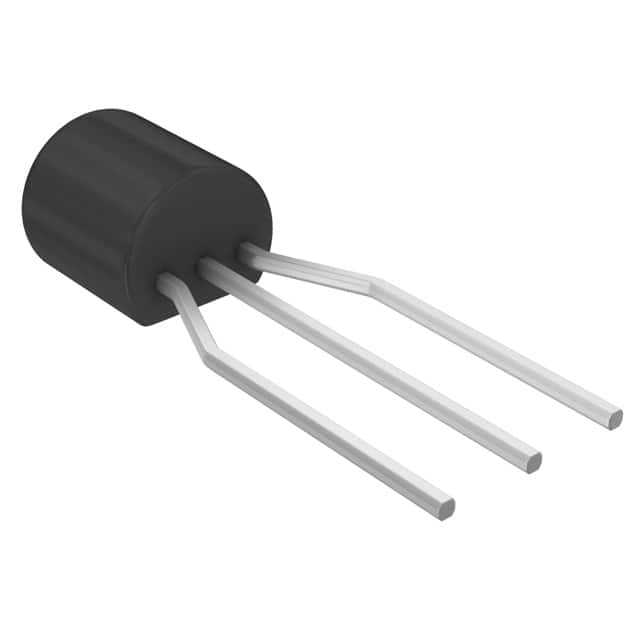Viz Specifikace pro podrobnosti o produktu.

MPSA29RLRP
Product Overview
Category
The MPSA29RLRP belongs to the category of bipolar transistors.
Use
It is commonly used as a general-purpose amplifier or switch in electronic circuits.
Characteristics
- Low noise
- High current gain
- Medium power dissipation
Package
The MPSA29RLRP is typically available in a TO-92 package.
Essence
This transistor is essential for amplifying and switching signals in various electronic applications.
Packaging/Quantity
It is usually packaged in reels or tubes, with quantities varying based on manufacturer specifications.
Specifications
- Collector-Base Voltage (VCBO): 75V
- Collector-Emitter Voltage (VCEO): 75V
- Emitter-Base Voltage (VEBO): 6V
- Collector Current (IC): 800mA
- Power Dissipation (PD): 625mW
- Transition Frequency (ft): 100MHz
- Operating Temperature Range: -55°C to 150°C
Detailed Pin Configuration
- Emitter (E)
- Base (B)
- Collector (C)
Functional Features
- High current gain allows for small base current to control larger currents in the collector-emitter circuit.
- Low noise makes it suitable for audio amplifier applications.
- Medium power dissipation enables it to handle moderate power levels.
Advantages
- Versatile use in both amplification and switching applications.
- Low noise performance.
- Compact TO-92 package for easy integration into circuit designs.
Disadvantages
- Limited power handling capabilities compared to higher-power transistors.
- Moderate frequency response limits its use in high-frequency applications.
Working Principles
The MPSA29RLRP operates based on the principles of bipolar junction transistors, where the flow of current between the collector and emitter is controlled by the base current.
Detailed Application Field Plans
- Audio Amplification: Utilized in low-power audio amplifiers due to its low noise characteristics.
- Switching Circuits: Employed in various electronic switches and relay driver circuits.
- Signal Amplification: Used in signal conditioning and amplification circuits in instrumentation and control systems.
Detailed and Complete Alternative Models
- BC337: Similar NPN transistor with comparable characteristics.
- 2N3904: Another NPN transistor commonly used for general-purpose amplification and switching.
In conclusion, the MPSA29RLRP is a versatile bipolar transistor with applications in amplification and switching circuits. Its low noise and high current gain make it suitable for various electronic designs, while its compact TO-92 package allows for easy integration. However, its moderate power handling and frequency limitations should be considered when selecting it for specific applications. Alternative models such as the BC337 and 2N3904 offer similar functionality and can be considered based on specific design requirements.
Seznam 10 běžných otázek a odpovědí souvisejících s aplikací MPSA29RLRP v technických řešeních
What is MPSA29RLRP?
- MPSA29RLRP is a high voltage NPN bipolar junction transistor (BJT) commonly used in electronic circuits for amplification and switching applications.
What are the typical applications of MPSA29RLRP?
- The MPSA29RLRP transistor is commonly used in audio amplifiers, voltage regulators, motor control circuits, and other general-purpose electronic applications.
What is the maximum voltage and current rating for MPSA29RLRP?
- The maximum collector-emitter voltage (VCEO) for MPSA29RLRP is 75V, and the maximum collector current (IC) is 800mA.
How do I determine the appropriate biasing and operating conditions for MPSA29RLRP?
- The biasing and operating conditions for MPSA29RLRP can be determined using the transistor's datasheet, which provides information on recommended operating points, maximum ratings, and electrical characteristics.
Can MPSA29RLRP be used for low-power applications?
- Yes, MPSA29RLRP can be used for low-power applications due to its moderate current and voltage ratings.
What are the key parameters to consider when designing a circuit with MPSA29RLRP?
- Key parameters to consider include the base current, collector current, voltage ratings, power dissipation, and frequency response of the transistor.
Are there any specific considerations for thermal management when using MPSA29RLRP?
- It is important to consider proper heat sinking and thermal management to ensure that the transistor operates within its temperature limits, as specified in the datasheet.
Can MPSA29RLRP be used in high-frequency applications?
- While MPSA29RLRP has moderate frequency response, it may not be suitable for very high-frequency applications due to its transition frequency and capacitance characteristics.
What are some common alternatives to MPSA29RLRP for similar applications?
- Common alternatives include 2N3904, BC547, and BC548 transistors, which have comparable characteristics and can be used in similar applications.
Where can I find additional resources and support for designing with MPSA29RLRP?
- Additional resources and support can be found from the manufacturer's website, electronics forums, and application notes related to BJT circuit design.

